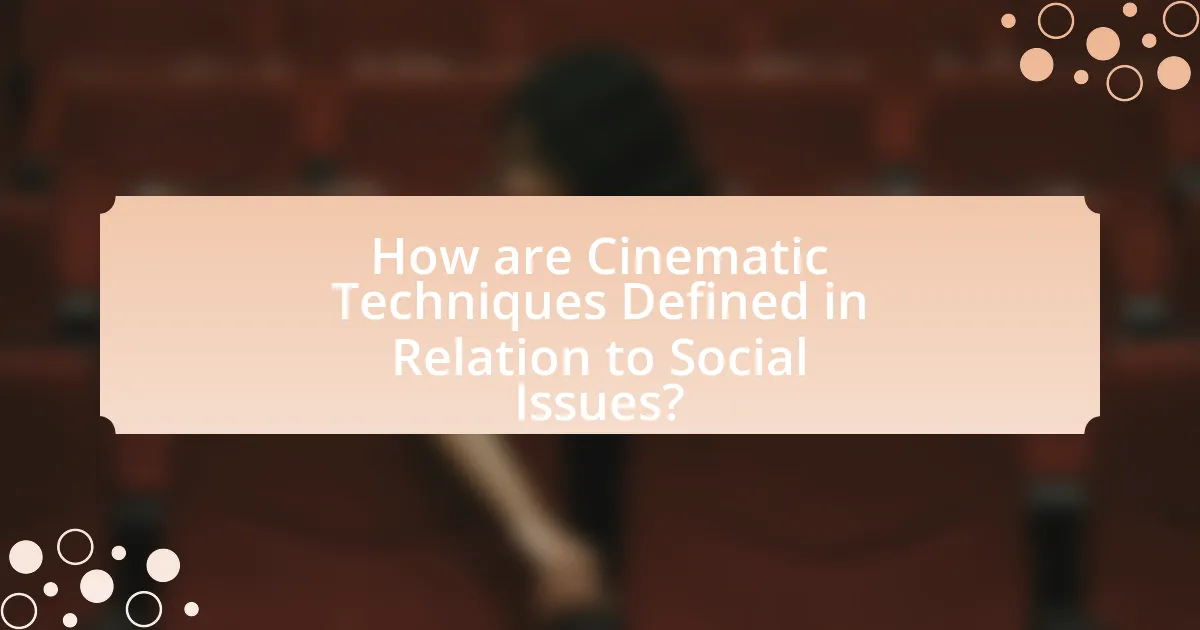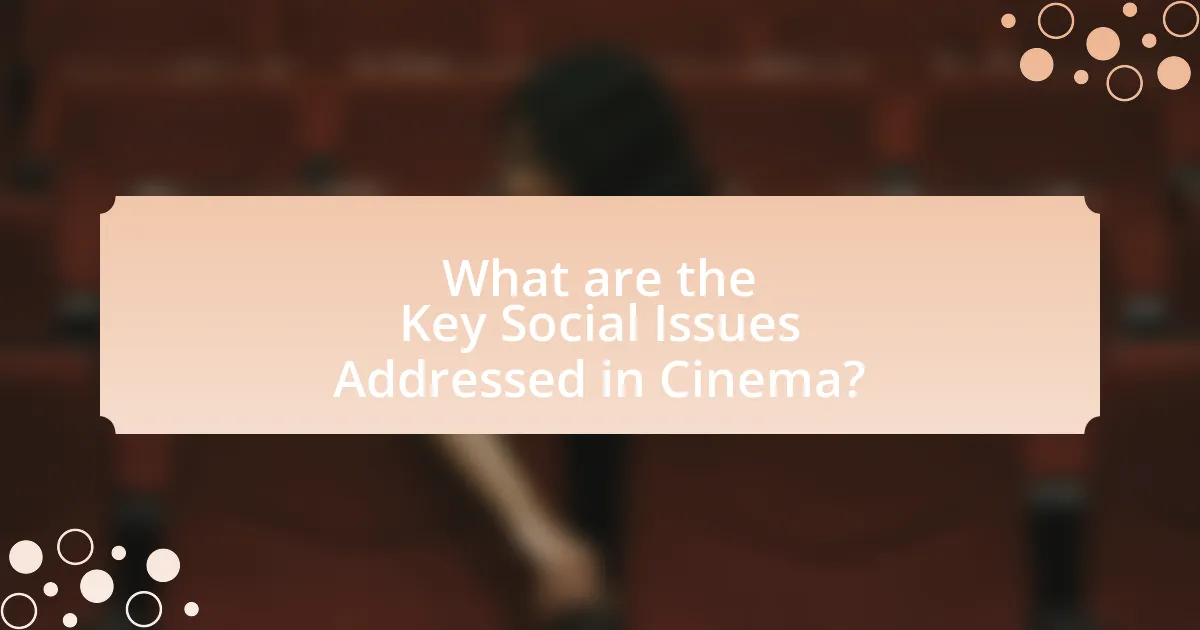Cinematic techniques are essential methods used by filmmakers to convey themes and messages related to social issues, including camera angles, lighting, sound, editing, and mise-en-scène. These techniques enhance visual storytelling, evoke emotional responses, and shape audience perceptions of societal challenges such as racism, poverty, and gender inequality. The article explores how specific cinematic elements, such as symbolism and sound design, contribute to the portrayal of social narratives, while also examining the historical context of cinema as a tool for social change. Additionally, it discusses the importance of authenticity and audience engagement in effectively addressing social issues through film.

How are Cinematic Techniques Defined in Relation to Social Issues?
Cinematic techniques are defined as the methods filmmakers use to convey themes and messages, particularly in relation to social issues. These techniques include camera angles, lighting, sound, editing, and mise-en-scène, which collectively shape the audience’s perception and emotional response to societal topics. For instance, the use of close-up shots can emphasize a character’s emotional struggle, effectively highlighting issues such as poverty or discrimination. Historical examples, such as the use of stark lighting in “Schindler’s List” to depict the horrors of the Holocaust, demonstrate how these techniques can evoke empathy and provoke critical thought about social injustices.
What are the primary cinematic techniques used in film?
The primary cinematic techniques used in film include cinematography, editing, sound design, mise-en-scène, and narrative structure. Cinematography involves the use of camera angles, lighting, and shot composition to create visual storytelling. Editing refers to the arrangement of shots to influence pacing and narrative flow. Sound design encompasses dialogue, sound effects, and music to enhance emotional impact. Mise-en-scène includes the arrangement of visual elements within a frame, such as set design and actor positioning, to convey meaning. Narrative structure dictates how the story is told, influencing audience engagement and interpretation. These techniques are essential for filmmakers to effectively communicate themes and address social issues within their narratives.
How do visual storytelling elements contribute to social narratives?
Visual storytelling elements significantly enhance social narratives by providing emotional depth and context that words alone cannot convey. These elements, such as imagery, color, composition, and movement, engage viewers on a sensory level, making complex social issues more relatable and impactful. For instance, the use of contrasting colors can symbolize conflict or harmony, while specific camera angles can evoke empathy or tension, effectively guiding audience perception. Research indicates that visual content is processed 60,000 times faster than text, underscoring its power in shaping narratives and influencing public opinion on social issues.
What role does sound design play in conveying social messages?
Sound design plays a crucial role in conveying social messages by enhancing emotional resonance and reinforcing narrative themes. It utilizes auditory elements such as music, sound effects, and silence to evoke specific feelings and reactions from the audience, thereby deepening their understanding of social issues. For instance, in films addressing topics like poverty or injustice, the use of dissonant sounds can create a sense of discomfort, while harmonious music may evoke hope or resilience. Research indicates that sound can significantly influence audience perception; a study published in the Journal of Media Psychology found that sound design directly affects emotional engagement and memory retention related to social themes. This demonstrates that effective sound design not only supports the visual narrative but also amplifies the intended social message, making it more impactful.
Why is it important to address social issues through cinema?
Addressing social issues through cinema is important because it raises awareness and fosters empathy among audiences. Cinema has the unique ability to portray complex social realities, allowing viewers to engage with diverse perspectives and experiences. For instance, films like “12 Years a Slave” and “The Pursuit of Happyness” highlight systemic injustices and personal struggles, prompting discussions about race and economic disparity. Research indicates that exposure to such narratives can lead to increased understanding and compassion, as demonstrated in studies published in the Journal of Communication, which show that storytelling in film can influence attitudes and behaviors regarding social issues.
How can films influence public perception of social issues?
Films can significantly influence public perception of social issues by shaping narratives and evoking emotional responses. Through storytelling, visual imagery, and character development, films can highlight social injustices, raise awareness, and foster empathy among audiences. For instance, the film “12 Years a Slave” effectively portrayed the brutal realities of slavery, leading to increased discussions about racial inequality and historical injustices. Research indicates that films can alter viewers’ attitudes and beliefs, as demonstrated by a study published in the Journal of Communication, which found that exposure to films addressing social issues can lead to greater social activism and support for policy changes.
What historical context supports the use of cinema for social change?
The historical context that supports the use of cinema for social change includes the emergence of early 20th-century movements such as the Soviet Montage movement, which utilized film as a tool for political propaganda and social critique. This movement, exemplified by filmmakers like Sergei Eisenstein, demonstrated how editing techniques could evoke emotional responses and inspire collective action among audiences. Additionally, the civil rights movement in the United States during the 1960s leveraged documentary films, such as “The Murder of Emmett Till,” to raise awareness about racial injustice and mobilize public opinion. These instances illustrate how cinema has historically served as a powerful medium for highlighting social issues and advocating for change.

What are the Key Social Issues Addressed in Cinema?
Key social issues addressed in cinema include racism, gender inequality, poverty, mental health, and environmental concerns. These themes are often explored through narratives that reflect societal challenges, such as systemic discrimination depicted in films like “12 Years a Slave,” which highlights the brutal realities of slavery and racism in America. Gender inequality is portrayed in movies like “Thelma & Louise,” showcasing women’s struggles for autonomy and equality. Poverty is a recurring theme in films such as “The Pursuit of Happyness,” illustrating the hardships faced by individuals in economically disadvantaged situations. Mental health issues are addressed in films like “A Beautiful Mind,” which portrays the complexities of living with schizophrenia. Environmental concerns are increasingly represented in cinema, as seen in “An Inconvenient Truth,” which raises awareness about climate change. These films not only entertain but also provoke thought and inspire dialogue on critical social issues.
Which social issues are most commonly depicted in films?
Social issues most commonly depicted in films include poverty, racism, gender inequality, mental health, and environmental concerns. These themes are prevalent as filmmakers often use storytelling to reflect societal challenges and provoke thought. For instance, films like “The Pursuit of Happyness” illustrate poverty, while “12 Years a Slave” addresses racism. Gender inequality is explored in movies such as “Thelma & Louise,” and mental health is a central theme in “A Beautiful Mind.” Environmental issues are highlighted in films like “An Inconvenient Truth.” These examples demonstrate how cinema serves as a medium for discussing and raising awareness about critical social issues.
How do films portray issues of inequality and injustice?
Films portray issues of inequality and injustice by using narrative structures, character development, and visual symbolism to highlight social disparities. For instance, films like “12 Years a Slave” depict the brutal realities of slavery, showcasing the dehumanization and suffering of enslaved individuals, which serves to raise awareness about historical and ongoing racial injustices. Additionally, movies such as “The Pursuit of Happyness” illustrate economic inequality through the struggles of a father facing homelessness while striving for a better life, effectively humanizing the issue of poverty. These cinematic techniques engage audiences emotionally, prompting reflection and discussion on societal issues, thereby reinforcing the importance of addressing inequality and injustice in real life.
What cinematic techniques are effective in highlighting environmental concerns?
Cinematic techniques that effectively highlight environmental concerns include visual imagery, sound design, and narrative structure. Visual imagery, such as wide shots of polluted landscapes or close-ups of endangered species, creates a stark contrast that emphasizes the impact of environmental degradation. Sound design, including the use of natural sounds versus industrial noise, can evoke emotional responses and raise awareness about ecological issues. Additionally, narrative structure that incorporates personal stories or testimonials can humanize environmental challenges, making them more relatable and urgent for the audience. These techniques have been utilized in films like “An Inconvenient Truth,” which combines compelling visuals and personal narrative to effectively communicate the urgency of climate change.
How do filmmakers choose which social issues to address?
Filmmakers choose which social issues to address based on a combination of personal passion, audience relevance, and cultural impact. They often select topics that resonate with their own experiences or beliefs, ensuring authenticity in storytelling. Additionally, filmmakers analyze current societal trends and issues that provoke public discourse, aiming to engage audiences emotionally and intellectually. For instance, films like “12 Years a Slave” and “The Pursuit of Happyness” tackle themes of racial injustice and economic hardship, respectively, reflecting pressing social concerns that resonate widely. This strategic selection process is supported by audience research and box office trends, indicating that films addressing relevant social issues often achieve greater viewer engagement and critical acclaim.
What factors influence the selection of social themes in cinema?
The selection of social themes in cinema is influenced by cultural context, audience demographics, and current societal issues. Cultural context shapes filmmakers’ perspectives and the themes they choose to explore, as seen in films that reflect the values and struggles of specific communities. Audience demographics, including age, gender, and socioeconomic status, dictate the themes that resonate with viewers, leading filmmakers to select topics that appeal to their target audience. Current societal issues, such as political movements or social justice campaigns, also drive the selection of themes, as filmmakers often aim to engage with pressing topics that spark conversation and reflection, exemplified by films addressing climate change or racial inequality.
How does audience demand shape the portrayal of social issues in films?
Audience demand significantly influences the portrayal of social issues in films by driving filmmakers to address topics that resonate with viewers. When audiences express interest in specific social issues, such as racial inequality or mental health, filmmakers often respond by incorporating these themes into their narratives to attract larger audiences and increase box office success. For instance, the success of films like “Black Panther,” which highlighted racial representation, demonstrates how audience demand can lead to a broader exploration of social themes in mainstream cinema. Additionally, box office data shows that films addressing contemporary social issues often perform better, indicating that audience preferences shape the content and focus of cinematic storytelling.

How Do Cinematic Techniques Effectively Convey Social Messages?
Cinematic techniques effectively convey social messages by utilizing visual storytelling elements such as cinematography, editing, sound design, and mise-en-scène to evoke emotional responses and highlight societal issues. For instance, the use of close-up shots can create intimacy with characters, allowing audiences to empathize with their struggles, as seen in films like “The Pursuit of Happyness,” where the protagonist’s hardships are emphasized through tight framing. Additionally, editing techniques, such as juxtaposition, can contrast different social realities, as demonstrated in “12 Years a Slave,” where the stark differences between freedom and enslavement are highlighted through rapid cuts. Sound design further enhances this impact; the use of silence or specific soundtracks can amplify the emotional weight of a scene, as evidenced in “Schindler’s List,” where the haunting score underscores the gravity of the Holocaust. These techniques collectively serve to engage viewers, provoke thought, and inspire action regarding social issues.
What specific techniques enhance the emotional impact of social narratives?
Specific techniques that enhance the emotional impact of social narratives include character development, visual storytelling, and sound design. Character development allows audiences to form emotional connections with protagonists, making their struggles and triumphs more relatable. Visual storytelling employs imagery, color palettes, and cinematography to evoke specific feelings; for instance, warm colors can create a sense of comfort, while dark tones may evoke sadness or tension. Sound design, including music and ambient sounds, further amplifies emotional responses by setting the tone and mood of scenes. Research indicates that films employing these techniques can significantly increase viewer empathy and engagement, as demonstrated in studies analyzing audience reactions to various cinematic approaches.
How does cinematography influence audience empathy towards social issues?
Cinematography significantly influences audience empathy towards social issues by visually framing narratives that evoke emotional responses. Techniques such as lighting, camera angles, and shot composition create an immersive experience that allows viewers to connect with characters and their struggles. For instance, close-up shots can capture nuanced facial expressions, fostering a sense of intimacy and understanding, while wide shots may contextualize characters within their environments, highlighting societal challenges. Research indicates that films employing these techniques can enhance emotional engagement; a study published in the Journal of Media Psychology found that viewers reported increased empathy when exposed to films that utilized effective cinematographic strategies to depict social issues.
What role does editing play in shaping the viewer’s understanding of social themes?
Editing plays a crucial role in shaping the viewer’s understanding of social themes by controlling the pacing, structure, and emotional impact of a narrative. Through techniques such as juxtaposition, transitions, and the selection of shots, editing can highlight contrasts between different social realities, thereby emphasizing the significance of the themes presented. For instance, in films like “12 Years a Slave,” rapid cuts between scenes of brutality and moments of humanity serve to underscore the harsh realities of slavery, guiding the audience’s emotional response and fostering a deeper comprehension of the social issues at hand. This manipulation of time and space in editing not only influences how viewers perceive the narrative but also encourages critical reflection on the societal themes being explored.
How can filmmakers use symbolism to address complex social issues?
Filmmakers can use symbolism to address complex social issues by embedding deeper meanings within visual elements, characters, and narratives that resonate with audiences. For instance, the use of color can symbolize emotions or societal conditions; in “Schindler’s List,” the girl in the red coat symbolizes innocence amidst the horrors of the Holocaust, effectively highlighting the tragedy of loss. Additionally, objects or recurring motifs can represent broader themes; in “The Great Gatsby,” the green light symbolizes the unattainable American Dream, critiquing social stratification. Such symbolic representations allow filmmakers to provoke thought and discussion about social issues, making complex themes more accessible and impactful for viewers.
What are some examples of effective symbolism in films addressing social issues?
Effective symbolism in films addressing social issues includes the use of the color red in “Schindler’s List,” which symbolizes the innocence lost during the Holocaust, particularly through the character of the girl in the red coat. Another example is the use of the wall in “The Wall,” which represents the emotional and psychological barriers people build due to trauma and societal pressures. Additionally, in “Get Out,” the deer symbolizes the vulnerability of Black individuals in a racially charged society, highlighting themes of exploitation and violence. These symbols serve to deepen the audience’s understanding of the social issues presented, making the films more impactful and thought-provoking.
How does the use of metaphor deepen the audience’s engagement with social topics?
The use of metaphor deepens the audience’s engagement with social topics by creating relatable and vivid imagery that resonates emotionally. Metaphors allow complex social issues to be understood through familiar concepts, making them more accessible and impactful. For instance, in films addressing poverty, depicting it as a “dark cloud” can evoke feelings of despair and urgency, prompting viewers to empathize with affected individuals. Research indicates that metaphors enhance memory retention and emotional response, as they activate multiple areas of the brain, facilitating a deeper connection to the subject matter. This cognitive engagement encourages audiences to reflect on social issues more critically and personally.
What are best practices for filmmakers addressing social issues through cinematic techniques?
Filmmakers addressing social issues should prioritize authenticity, emotional engagement, and diverse perspectives in their cinematic techniques. Authenticity ensures that the representation of social issues is accurate and respectful, which can be achieved through thorough research and collaboration with affected communities. Emotional engagement can be fostered by using storytelling techniques that resonate with audiences, such as character-driven narratives that highlight personal experiences related to the social issue. Diverse perspectives are crucial; filmmakers should include voices from various backgrounds to provide a comprehensive view of the issue, which can enhance the film’s impact and relatability. For instance, films like “12 Years a Slave” effectively utilized these practices by portraying the harsh realities of slavery through authentic storytelling and diverse character experiences, leading to critical acclaim and increased awareness of historical injustices.
How can filmmakers ensure authenticity in their portrayal of social issues?
Filmmakers can ensure authenticity in their portrayal of social issues by engaging with communities affected by those issues and incorporating their voices into the narrative. This approach allows filmmakers to present accurate representations and avoid stereotypes. For instance, the documentary “13th” by Ava DuVernay effectively highlights systemic racism by including interviews with scholars, activists, and individuals impacted by mass incarceration, providing a multifaceted perspective on the issue. Engaging with experts and conducting thorough research further enhances the authenticity of the portrayal, as seen in films like “Spotlight,” which meticulously investigated the Catholic Church’s abuse scandal through real-life interviews and documentation.
What strategies can be employed to engage audiences effectively with social narratives?
To engage audiences effectively with social narratives, employing relatable characters and authentic storytelling is essential. Relatable characters allow viewers to see themselves in the narrative, fostering emotional connections that enhance engagement. Authentic storytelling, which reflects real-life experiences and societal issues, resonates with audiences and encourages reflection and discussion. For instance, films like “12 Years a Slave” utilize historical accuracy and personal stories to evoke empathy and raise awareness about slavery, demonstrating how powerful narratives can drive social change.